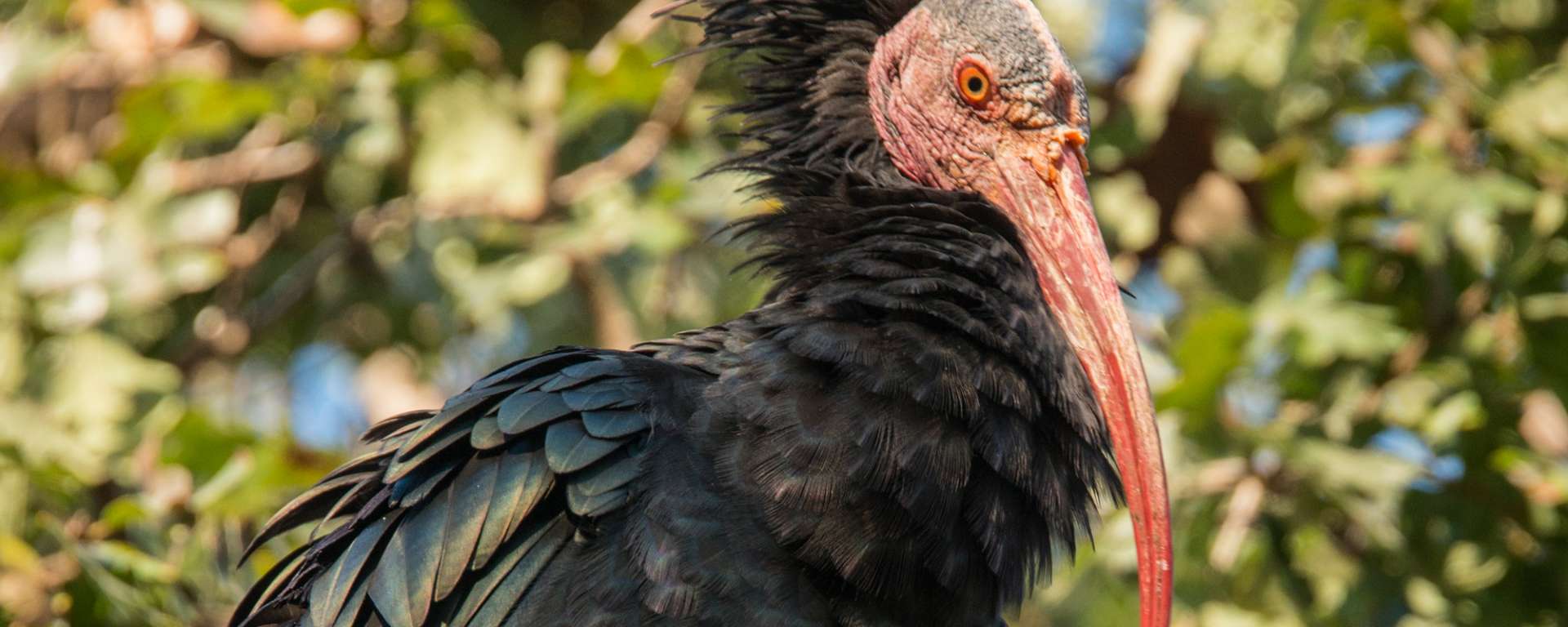Safari Spotlight: Northern Bald Ibis
Posted in: Safari Spotlight
Tags: Northern bald ibis
The Northern bald ibis, also known as the Waldrapp’s ibis could be considered a scary looking bird. At first glance, their bald, red-skinned heads and glossy black plumage make them look like small vultures. A collar of long black feathers burst back from around the neck which has the effect of making the birds appear almost as though they’re wearing capes. It’s a villainous look to be sure. This sinister appearance isn’t helped by their habit of peering down at us visiting humans from their nesting platforms high above our heads.
While the ibis does sport a very vulture-like look and isn’t above eating the occasional dead lizard or mouse, they aren’t typically scavengers. They are better described as omnivorous generalists. Normally, the glossy black birds are found foraging in open areas of sparse vegetation where they seek out small animal prey including bugs, worms, and small mammals. Not strictly carnivorous, the ibises will also chow down on berries, plant material of various types, and duckweed. Ibises of all species are known for their long, sensitive downward curving bill, and just like all of their cousins, the Northern bald ibis puts this valuable tool to work, probing about in the soft soil or beneath the water in their never-ending quest for sustenance.
While the Northern bald ibis is perhaps not the most flamboyant or beautiful of feathered creatures, they are among the most interesting birds we have here on property for a somewhat discouraging reason. The ibis is critically endangered and has been since at least the early 1990’s. If we were to rewind the clock a few hundred years, we’d find Northern bald ibises throughout North Africa, the Middle East and into Europe. Most of these birds were migratory animals, taking advantage of the mild European spring to breed and then heading south to Africa as winter approached. Two to three hundred years ago, the migratory ibises began to disappear from Europe for reasons we still don’t quite understand. Cut back to modern day and the few remaining ibis populations are found in just a couple of geographically isolated pockets in Africa and the Middle East.
The last truly wild, sustainable population of Northern bald ibises exists in Morocco and interestingly, they are a resident population. Rather than migrating long distances between the temperate north and semi-tropical south, these birds seem to have settled down in between. During the breeding season, the ibises congregate in Souss-Massa national park in Morocco. There they build nests on ledges in the coastal cliff sides where they are largely protected from predation. They breed in one of four extant colonies and then when the newest generation of chicks are fledged, they disperse along the north-western coast of Africa to forage and fly until the next breeding season calls them back together again.
In the Middle East, the ibis population is all but extinct. Today there exists what we call a semi-wild population in Turkey. This group is managed in the sense that they live wild throughout most of the year, but are captured and contained each autumn to prevent them from attempting the long migration into east Africa. They simply do not survive the trip and so the decision has been made to keep them safe in Turkey instead. If they were to migrate, their path would take them through Syria where ibises had been thought long extinct until a small colony was rediscovered there in 2002. The rediscovered colony of seven individuals immediately garnered scientific attention and some degree of protection. At first, the Syrian birds achieved greater breeding success than any other extant population. Their successes, however, were short lived and the population, already critically small, experienced several failed breeding seasons. Each year, fewer and fewer birds returned from the migration south to the Ethiopian highlands and by 2012 only two birds returned to the colony. We no longer have reliable data about the Syrian population because the colony sits right next to Palmyra, a city which has been occupied and reoccupied by different armies throughout the Syrian civil war. It was only recently liberated from control by ISIL. It is expected that the Syrian population is once again extinct.
In spite of all of these setbacks, recent news of the Northern bald ibis has been somewhat promising. Their numbers, at least in the Moroccan population seem to be climbing. By the end of the 20th century, it was estimated that only 50 breeding pairs of Northern bald ibises remained in the world. At the tail end of 2015, Birdlife International happily announced that the colonies of Morocco now support 116 breeding pairs and a total population of approximately 600 birds.
Safari West is currently home to five of these charismatic birds and we are working toward a successful breeding program ourselves. Genetic diversity and greater understanding of the biology and life cycle of these majestic birds are the greatest tools we have in the fight to preserve their species. There has never been a more dynamic time for the Northern bald ibis than right now. Updates and new information about this species appear regularly and lately, it’s been mostly good. Come to Safari West and meet these fascinating birds face to red skinned face. You never know when the next bit of news is going to come in and it’s always exciting to be with the birds when it does.

